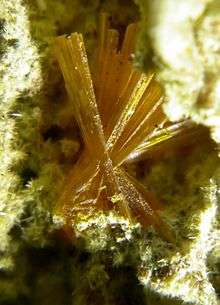Becquerelite
Becquerelite is a uranium mineral with the chemical formula: Ca(UO2)6O4(OH)6·8(H2O). It is a secondary mineral which contains calcium and is a bright yellow colour. It has a Mohs hardness of about 2.
| Becquerelite | |
|---|---|
 Spray of becquerelite crystals with uranophane needles from the old Shinkolobwe mine | |
| General | |
| Category | Oxide mineral |
| Formula (repeating unit) | Ca(UO2)6O4(OH)6·8(H2O) |
| Strunz classification | 4.GB.10 |
| Crystal system | Orthorhombic |
| Crystal class | Pyramidal (mm2) H-M symbol: (mm2) |
| Space group | Pn21a |
| Unit cell | a = 13.8378 Å, b = 12.3781 Å, c = 14.9238 Å; Z = 4 |
| Identification | |
| Colour | Amber-yellow, golden to lemon-yellow, yellow-orange, brownish yellow |
| Crystal habit | Tabular prismatic striated crystals exhibiting pseudohexagonal outline; coatings and fine-grained aggregates |
| Cleavage | Perfect on {001}; imperfect on {101}, {010} and {110} |
| Tenacity | Brittle |
| Mohs scale hardness | 2.5 |
| Lustre | Adamantine to greasy |
| Streak | Yellow |
| Diaphaneity | Transparent |
| Specific gravity | 5.09 - 5.2 |
| Optical properties | Biaxial (-) |
| Refractive index | nα = 1.725 - 1.735 nβ = 1.815 - 1.825 nγ = 1.825 - 1.830 |
| Birefringence | δ = 0.100 |
| Pleochroism | X = colourless to pale yellow, Y = Z = yellow to deep yellow |
| 2V angle | Measured: 32° |
| Common impurities | Commonly contains lead |
| Other characteristics | |
| References | [1][2][3] |
It was named after the French physicist Antoine Henri Becquerel (1852–1908), who discovered radioactivity in 1896. Becquerelite contains about 70% uranium by weight.
It is mainly mined in Kasolo of the former Zaire, in the present day Democratic Republic of the Congo.
This article is issued from Wikipedia. The text is licensed under Creative Commons - Attribution - Sharealike. Additional terms may apply for the media files.